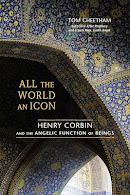"...the Imagination (or love, or sympathy, or any other sentiment) induces knowledge, and knowledge of an 'object' which is proper to it..."
Henry Corbin (1903-1978) was a scholar, philosopher and theologian. He was a champion of the transformative power of the Imagination and of the transcendent reality of the individual in a world threatened by totalitarianisms of all kinds. One of the 20th century’s most prolific scholars of Islamic mysticism, Corbin was Professor of Islam & Islamic Philosophy at the Sorbonne in Paris and at the University of Teheran. He was a major figure at the Eranos Conferences in Switzerland. He introduced the concept of the mundus imaginalis into contemporary thought. His work has provided a foundation for archetypal psychology as developed by James Hillman and influenced countless poets and artists worldwide. But Corbin’s central project was to provide a framework for understanding the unity of the religions of the Book: Judaism, Christianity and Islam. His great work Alone with the Alone: Creative Imagination in the Sufism of Ibn ‘Arabi is a classic initiatory text of visionary spirituality that transcends the tragic divisions among the three great monotheisms. Corbin’s life was devoted to the struggle to free the religious imagination from fundamentalisms of every kind. His work marks a watershed in our understanding of the religions of the West and makes a profound contribution to the study of the place of the imagination in human life.Search The Legacy of Henry Corbin: Over 800 Posts
Thursday, February 19, 2009
Idols & Icons
 Corbin writes that idolatry is "that two-faced spiritual infirmity which consists in either loving an object without transcendence, or in misunderstanding that transcendence by separating it from the loved object, through which alone it is manifested. These two aspects spring from the same cause: in both cases a man becomes incapable of the sympathy which gives beings and forms their transcendent dimension… The cause may be a will to power, dogmatic or otherwise, which wishes to immobilize beings and forms at the point where man has immobilized himself - perhaps out of a secret fear of the infinite successions of perpetual transcendences...and [the knowledge that]...to be faithful to the Angel is precisely to let ourselves be guided by him towards the transcendences that he announces." - Creative Imagination in the Sufism of Ibn 'Arabi, 134
Corbin writes that idolatry is "that two-faced spiritual infirmity which consists in either loving an object without transcendence, or in misunderstanding that transcendence by separating it from the loved object, through which alone it is manifested. These two aspects spring from the same cause: in both cases a man becomes incapable of the sympathy which gives beings and forms their transcendent dimension… The cause may be a will to power, dogmatic or otherwise, which wishes to immobilize beings and forms at the point where man has immobilized himself - perhaps out of a secret fear of the infinite successions of perpetual transcendences...and [the knowledge that]...to be faithful to the Angel is precisely to let ourselves be guided by him towards the transcendences that he announces." - Creative Imagination in the Sufism of Ibn 'Arabi, 134The light that illuminates an icon comes from within and can reveal all of Creation, Corbin says, as "one immense iconostasis." "Idolatry consists in immobilizing oneself before an idol because one sees it as opaque, because one is incapable of discerning in it the hidden invitation that it offers to go beyond it. Hence, the opposite of idolatry would not consist in breaking idols, in practicing a fierce iconoclasm aimed against every inner or external Image; it would rather consist in rendering the idol transparent to the light invested in it. In short, it means transmuting the idol into an icon." - "Theophanies and Mirrors: Idols or Icons", (from - La philosophie iranienne Islamique aux XVIIIe et XVIIIe Siecles, 364)
The concept of the icon is central to Corbin's work. Any attempt to extend and develop the implications of his vision requires meditation on the meaning of the icon in the modern, and postmodern world. Such a project opens onto a vast landscape. For some pathways into this world there is a fascinating and suggestive syllabus for a course taught at Harvard Divinity School by Nicholas Constas in 2001. I have made this available online as a Google Document: Theology of the Icon. (The page has since disappeared from the internet, and I have not been able to find current contact information for Dr. Constas. If anyone can help with this I would appreciate it.) My tentative sketch of a project linking Corbin's work to aspects of contemporary theology, particularly the work of Jean-luc Marion, can be read here as a Google Document. Part of this larger project would involve consideration of theology and the arts, including film. I begin a selected Bibliography below.
Idols & Icons in Modern Theology
Jean-luc Marion, The Idol and Distance, God Without Being, The Crossing of the Visible, Being Given, In Excess and The Erotic Phenomenon.
Film as Icon
Gerard Loughlin, "Within the image : film as icon," in Johnston, Robert K. Reframing Theology and Film: New Focus for an Emerging Discipline. Grand Rapids, Mich: Baker Academic, 2007.
Gunnlaugur A. Jónsson, and Þorkell Ágúst Óttarsson. Through the Mirror: Reflections on the Films of Andrei Tarkovsky. Newcastle, U.K.: Cambridge Scholars Press, 2006.
Still image from Andrei Tarkovsky's Nostalghia.
Subscribe to:
Post Comments (Atom)






No comments:
Post a Comment